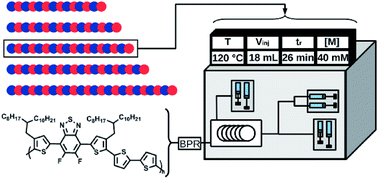Molecular weight tuning of low bandgap polymers by continuous flow chemistry: increasing the applicability of PffBT4T for organic photovoltaics†
Abstract
Continuous flow chemistry has been shown to be a suitable method for the large-scale preparation of conjugated polymers with uniform structural and macromolecular characteristics, which is especially relevant when applying these materials in optoelectronic devices. The molecular weight and dispersity of conjugated polymers have a major effect on final device performance through a combination of processing and morphological considerations. In this work, the low bandgap polymer PffBT4T-2OD (‘PCE-11’), which provides highly efficient bulk heterojunction solar cells, is synthesized by continuous flow chemistry using an easily mountable home-made apparatus. The influence of various reaction parameters on the material characteristics is investigated. Particular attention is devoted to tuning of the molecular weight, as this has a major impact on solubility and processability of the resultant polymer and, ultimately, solar cell performance. We find that temperature, monomer concentration, and injection volume of the polymerization mixture are significant parameters that can be used to optimize the control over molecular weight. The same protocol is then also applied to a structurally similar polymer with longer alkyl side chains, PffBT4T-2DT, affording important advantages in terms of processing due to its higher solubility. An average power conversion efficiency of 9.4% for bulk heterojunction solar cells using PC71BM as the acceptor phase is achieved based on this flow-synthesized polymer.



 Please wait while we load your content...
Please wait while we load your content...